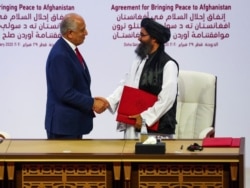Afghanistan’s civilians continue to die in high numbers, more than 500 in the first quarter of 2020, despite the signing of a deal between the United States and Taliban to end hostilities, said a United Nations report released Monday.
More than 150 children were killed during the first three months of the year and in addition to the deaths hundreds of people were wounded, according to the quarterly report tracking civilian casualties by the U.N. Assistance Mission in Afghanistan.
“I call on all parties to seize the opportunity offered by the Secretary-General’s call for a global ceasefire to focus collective efforts on fighting a common enemy, the COVID-19 pandemic,” said Deborah Lyons, the Secretary-General’s Special Representative for Afghanistan and head of UNAMA.
While anti-government forces, including the Taliban and Islamic State group were blamed for 55% of the civilian deaths, pro-government forces were blamed for killing more children, mostly due to airstrikes and indirect fire during ground engagements.
Of the 710 casualties—282 killed and 428 wounded—blamed on anti-government forces, the report attributed 39% to the Taliban, 13% to the local Islamic State chapter and the remainder to others.
“The number of civilian deaths attributed to Anti-Government Elements – particularly the Taliban – increased by 22% in the first quarter of 2020 as compared to the same time period in 2019, mainly due to a disturbing increase in targeted killings and summary executions,” the report said.
In one such incident cited in the report, seven adult men, including a teacher, were abducted and summarily executed by the Taliban in Kushk district of Herat province.
On the other side, the 412 civilian casualties included 198 killed and 214 wounded. Twenty-one percent of those, UNAMA said, were caused by Afghan security forces, 8% by international forces, and the rest by pro-government armed groups.
UNAMA expressed particular concern on the increase in violence in March, calling it “all the more striking” since the month followed a week-long period of reduction in violence in Afghanistan at the end of February that culminated in the signing of the U.S.-Taliban deal. The deal had raised expectations that levels of violence in Afghanistan would stay low.
The Taliban have rejected the report, saying that its own commission for the prevention of civilian casualties has managed to reduce the numbers from their side to almost zero.
“The UNAMA report has attributed some incidents to the Mujahedeen of Islamic Emirate which have either been caused by old landmines or due to personal feuds,” Taliban spokesman Zabiullah Mujahid said in a statement sent to journalists.
The insurgent group accused UNAMA of concealing casualties caused by the American and Afghan forces in airstrikes and other attacks.
Apart from the casualties, the report also expressed concern that healthcare workers continued to face the brunt of violence, either through indirect fire from nearby firefights, or, in one incident, abduction of five healthcare workers and their driver by Taliban. They were released after a two-day mediation by local elders.
“UNAMA calls on all parties to immediately cease fighting in the vicinity of healthcare facilities as well as the use of indirect fire (mortars, rockets, grenades) in populated areas that could impact healthcare facilities, medical transports, and patients’ access to health care,” the report said.
The level of civilian casualties remains low compared to the same quarter last year, a 29% decrease and the lowest figure for a first quarter since 2012.









